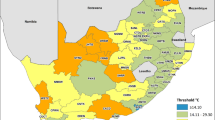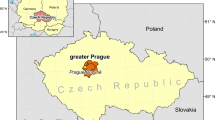Abstract
Several watch and warning systems have been established in the world in recent years to prevent the effects of heat waves. However, many of these approaches can be applied only in regions with perfect conditions (e.g., enough data, stationary series or homogeneous regions). Furthermore, a number of these approaches do not account for possible trend in mortality and/or temperature series, whereas others are generally not adapted to regions with low population densities or low daily mortality levels. In addition, prediction based on multiple days preceding the event can be less accurate if it attributes the same importance to each of these days, since the forecasting accuracy actually decreases with the period. The aim of the present study was to identify appropriate indicators as well as flexible and general thresholds that can be applied to a variety of regions and conditions. From a practical point of view, the province of Québec constitutes a typical case where a number of the above-mentioned constraints are present. On the other hand, until recently, the province’s watch and warning system was based on a study conducted in 2005, covering only the city of Montreal and applied to the whole province. The proposed approach is applied to each one of the other health regions of the province often experiencing low daily counts of mortality and presenting trends. The first constraint led to grouping meteorologically homogeneous regions across the province in which the number of deaths is sufficient to carry out the appropriate data analyses. In each region, mortality trends are taken into account. In addition, the proposed indicators are defined by a 3-day weighted mean of maximal and minimal temperatures. The sensitivity of the results to the inclusion of traumatic deaths is also checked. The application shows that the proposed method improved the results in terms of sensitivity, specificity and number of yearly false alarms, compared to those of the existing and other classical approaches. An additional criterion based on the Humidex is applied in a second step and a local validation is applied to historical observations at reference forecasting stations. An integrated heat health watch and warning system with thresholds that are adapted to the regional climate has thus been established for each sub-region of the province of Quebec and became operational in June 2010.




Similar content being viewed by others

References
Altman DG, Bland JM (1994) Statistics notes: diagnostic tests 1: sensitivity and specificity. BMJ 308(6943):1552
Baccini M, Kosatsky T, Analitis A, Anderson HR, D’Ovidio M, Menne B, Michelozzi P, Biggeri A (2011) Impact of heat on mortality in 15 European cities: attributable deaths under different weather scenarios. J Epidemiol Community Health 65(1):64–70
Bernard SM, McGeehin MA (2004) Municipal heat wave response plans. Am J Public Health 94(9):1520–1522
Cakmak S, Dales RE, Vidal CB (2007) Air pollution and mortality in Chile: susceptibility among the elderly. Environ Health Perspect 115(4):524
Claessens Y-E, Taupin P, Kierzek G, Pourriat J-L, Baud M, Ginsburg C, Jais J-P, Jougla E, Riou B, Dhainaut J-F, Landais P (2006) How emergency departments might alert for prehospital heat-related excess mortality? Crit Care 10(6):R156
Curriero FC, Heiner KS, Samet JM, Zeger SL, Strug L, Patz JA (2002) Temperature and mortality in 11 cities of the eastern United States. Am J Epidemiol 155(1):80–87
DSPM (2007) Heat health warning system workshop—Montreal, Quebec, Canada
Ebi KL, Teisberg TJ, Kalkstein LS, Robinson L, Weiher RF (2004) Heat watch/warning systems save lives. Bull Am Meteorol Soc 85(8):1067–1073
Gérardin V, McKenney D (2001) Une classificationclimatique du Québec à partir de modèles de distributionspatiale de données climatiques mensuelles: vers unedéfinition des bioclimats du Québec. Contribution duservice de la cartographie e´cologique No. 60. Ministèrede l’Environnement, Québec.
Hajat S, Kosatky T (2010) Heat-related mortality: a review and exploration of heterogeneity. J Epidemiol Community Health 64(9):753–760
Johnson DP, Wilson JS (2009) The socio-spatial dynamics of extreme urban heat events: the case of heat-related deaths in Philadelphia. Appl Geogr 29(3):419–434
Josseran L, Caillere N, Brun-Ney D, Rottner J, Filleul L, Brucker G, Astagneau P (2009) Syndromic surveillance and heat wave morbidity: a pilot study based on emergency departments in France. BMC Med Inf Dec Making 9:9
Kalkstein LS (1991) A new approach to evaluate the impact of climate on human mortality. Environ Health Perspect 96:145–150
Kalkstein LS, Jamason PF, Greene JS, Libby J, Robinson L (1996) The Philadelphia hot weather-health watch/warning system: development and application, summer 1995. Bull Am Meteorol Soc 77(7):1519–1528
Kalkstein LS, Greene S, Mills DM, Samenow J (2011) An evaluation of the progress in reducing heat-related human mortality in major US cities. Nat Hazard 56(1):113–129
Kaufman L, Rousseeuw PJ (2005) Finding groups in data: an introduction to cluster analysis. Wiley, New York
Koppe C, Kovats S, Jendritzky G and Menne B (2004) Heat waves: risks and responses, WHO health and global envrionnemental change series n° 2. WHO Geneva, 123, 2004
Kovats RS, Ebi KL (2006) Heatwaves and public health in Europe. Eur J Public Health 16(6):592–599
Kovats RS, Hajat S (2008) Heat stress and public health: a critical review. Annu Rev Public Health 29:41–55
Laaidi K, Pascal M (2004) Système d’alerte canicule et santé 2004 (Sacs 2004). Institut national de veille sanitaire de France (InVS), France, p 35
Litvak E, Fortier I, Gouillou G, Jehanno A, and Kosatsky T (2005) Programme de vigie et de prévention des effets de la chaleur accablante à Montréal. Direction de la santé publique de Montréal (DSPM)
Lorenz EN (1982) Atmospheric predictability experiments with a large numerical model. Tellus 34(6):505–513
Martel B, Giroux JX, Gosselin P, Chebana F, Ouarda TBMJ, Charron C (2010) Indicateurs et seuils météorologiques pour les systèmes de veille-avertissement canicule pour le Québec. INSPQ-INRS, Québec, p 119
Masterton J, Richardson F (1979) Humidex: a method of quantifying human discomfort due to excessive heat and humidity. Environment Canada, Downsview, Ontario
McGeehin MA, Mirabelli M (2001) The potential impacts of climate variability and change on temperature-related morbidity and mortality in the united states. Environ Health Perspect 109(Supplement 2):185–189
Metzger KB, Ito K, Matte TD (2010) Summer heat and mortality in New York city: how hot is too hot? Environ Health Perspect 118(1):80–86
Michelozzi P, Kirchmayer U, Katsouyanni K, Biggeri A, McGregor G, Menne B, Kassomenos P, Anderson HR, Baccini M, Accetta G (2007) Assessment and prevention of acute health effects of weather conditions in Europe, the PHEWE project: background, objectives, design. Environ Health 6(1):12
Michelozzi P, Accetta G, De Sario M, D’Ippoliti D, Marino C, Baccini M, Biggeri A, Anderson HR, Katsouyanni K, Ballester F (2009) High temperature and hospitalizations for cardiovascular and respiratory causes in 12 European cities. Am J Respir Crit Care Med 179(5):383
Nicholls N, Skinner C, Loughnan M, Tapper N (2008) A simple heat alert system for Melbourne, Australia. Int J Biometeorol 52(5):375–384
Pascal M, Laaidi K, Ledrans M, Baffert E, Caserio-Schönemann C, Le Tertre A, Manach J, Medina S, Rudant J, Empereur-Bissonnet P (2006) France’s heat health watch warning system. Int J Biometeorol 50(3):144–153
Pauli F, Rizzi L (2008) Analysis of heat wave effects on health by using generalized additive model and bootstrap-based model selection. J R Stat Soc Ser C-Appl Stat 57(4):473–485
Ruddell DM, Harlan SL, Grossman-Clarke S, Buyantuyev A (2010) Risk and exposure to extreme heat in microclimates of Phoenix, AZ. In: Showalter P, Lu Y (eds) Geospatial techniques in urban hazard and disaster analysis. Springer, New York, pp 179–202
Santee W (2005) Use of Humidex to set thermal work limits for emergency workers in protective clothing. DTIC Document
Schnetzler AE, Martin WM, Fransen TJ, Kalkstein LS (2010) Development of a Heat/Health Watch-Warning System for Glasgow, Montana: a prototype for small population areas, Paper presented at 14th Great Divide Weather Workshop in Billings Montana. November 2–4
Sheridan SC (2002) The redevelopment of a weather–type classification scheme for North America. Int J Climatol 22(1):51–68
Sheridan SC, Dolney TJ (2003) Heat, mortality, and level of urbanization: measuring vulnerability across Ohio, USA. Clim Res 24(3):255–265
Sheridan SC, Kalkstein LS (2004) Progress in heat watch-warning system technology. Bull Am Meteorol Soc 85(12):1931–1942
Smoyer KE, Rainham DGC, Hewko JN (2000) Heat-stress-related mortality in five cities in Southern Ontario: 1980–1996. Int J Biometeorol 44(4):190–197
Smoyer-Tomic KE, Rainham D (2001) Beating the heat: development and evaluation of a Canadian hot weather health-response plan. Environ Health Perspect 109(12):1241
Smoyer-Tomic KE, Kuhn R, Hudson A (2003) Heat wave hazards: an overview of heat wave impacts in Canada. Nat Hazard 28(2):465–486
Steadman RG (1979) The assessment of sultriness. Part I: a temperature-humidity index based on human physiology and clothing science. J Appl Meteorol 18(7):861–873
Weir E (2002) Heat wave: first, protect the vulnerable. Can Med Assoc J 167(2):169
Weisskopf MG, Anderson HA, Foldy S, Hanrahan LP, Blair K, Torok TJ, Rumm PD (2002) Heat wave morbidity and mortality, Milwaukee, Wis, 1999 vs 1995: an improved response? Am J Public Health 92(5):830–833
Acknowledgments
This project was funded by the Fonds vert in the context of Action 21 of the 2006–2012 Quebec Action Plan on Climate Change. The authors thank the Ministry of Health and Social Services of Quebec and the Ministry of Sustainable Development, Environment and Parks of Quebec of their funding and support for this project. The authors wish also to thank Marc Beauchemin and Stéphane Gagnon from Environment Canada, as well as Eric Litvak (U. Sherbrooke) for their valuable advice, and Christian Charron for securing access to the data. The authors thank the reviewers, the Associate Editor and the Editor-in-Chief for their comments, which significantly improved the quality and clarity of the paper. We acknowledge the partial contribution of the IRIACC-FACE program of IDRC (Canada).
Author information
Authors and Affiliations
Corresponding author
Rights and permissions
About this article
Cite this article
Chebana, F., Martel, B., Gosselin, P. et al. A general and flexible methodology to define thresholds for heat health watch and warning systems, applied to the province of Québec (Canada). Int J Biometeorol 57, 631–644 (2013). https://doi.org/10.1007/s00484-012-0590-2
Received:
Revised:
Accepted:
Published:
Issue Date:
DOI: https://doi.org/10.1007/s00484-012-0590-2



